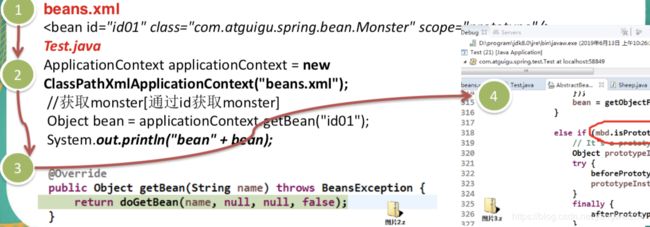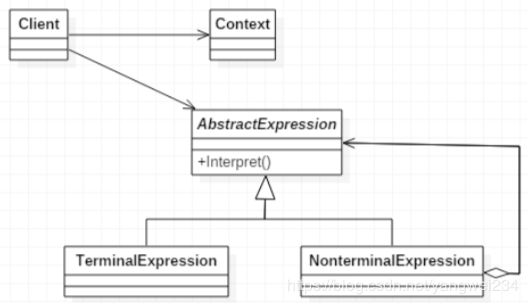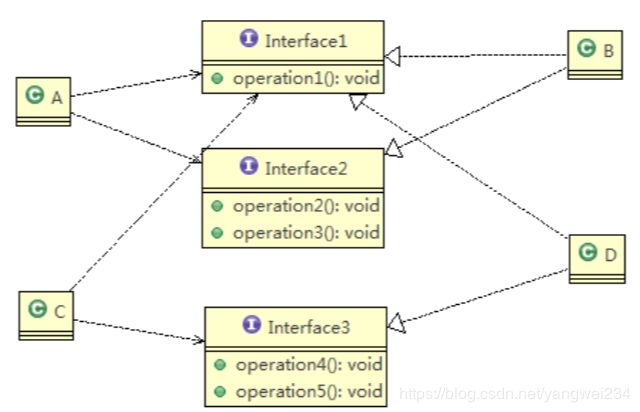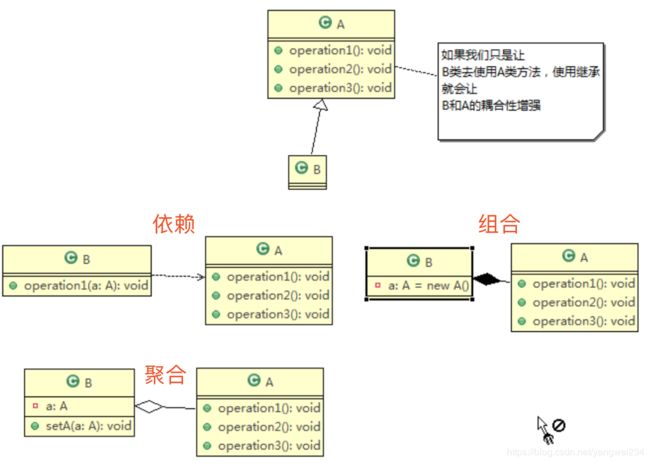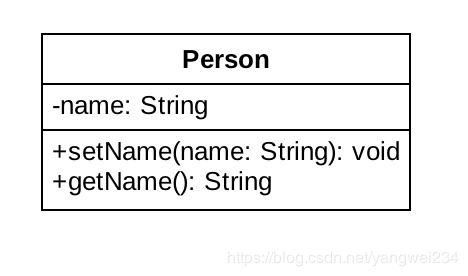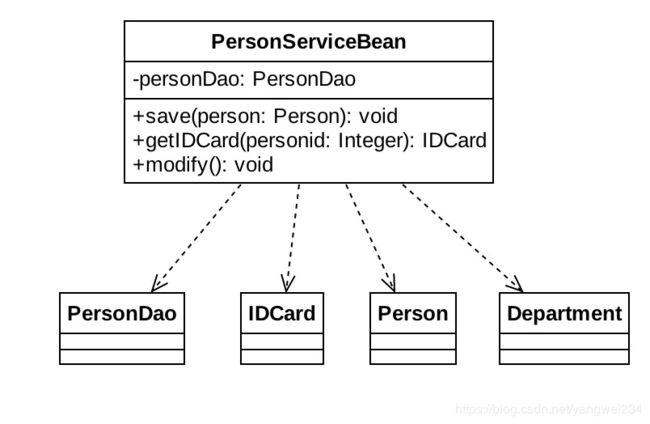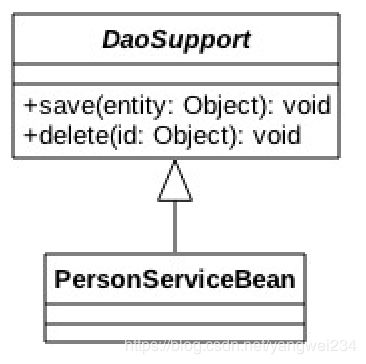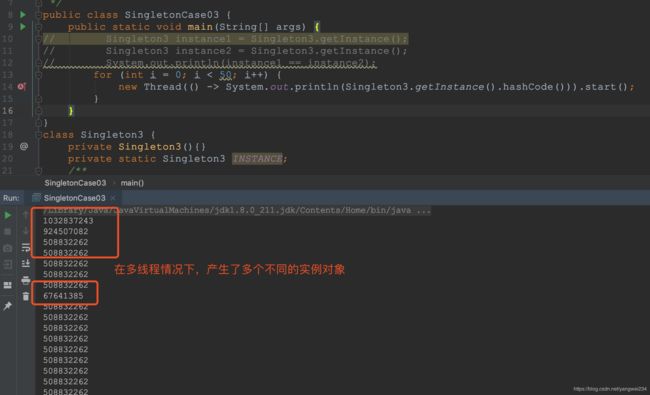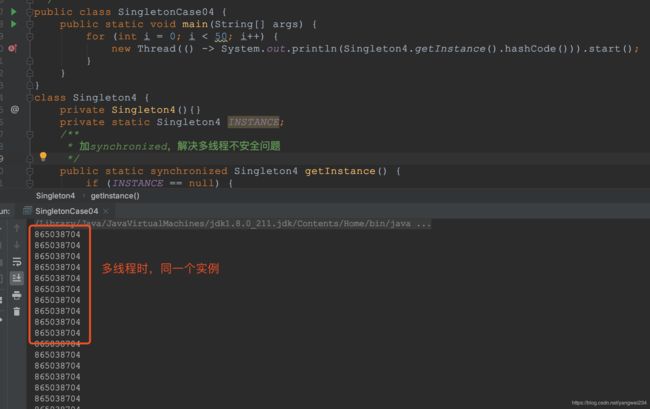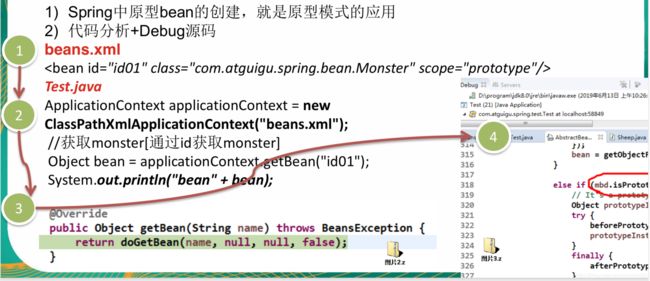Java后端架构师的成长之路(二)——Java设计模式(1)
Java设计模式
- Java设计模式入门
- 先看几个经典的面试题
- 原型设计模式问题
- 设计模式的七大原则
- 金融借贷平台项目
- 解释器设计模式
- 单例设计模式
- 设计模式的重要性
- 设计模式七大原则
- 设计模式的目的
- 设计模式七大原则
- 单一职责原则
- 基本介绍
- 应用实例
- 单一职责原则注意事项和细节
- 接口隔离原则
- 基本介绍
- 应用实例
- 应传统方法的问题和使用接口隔离原则改进
- 依赖倒转原则
- 基本介绍
- 应用实例
- 依赖关系传递的三种方式
- 依赖倒转原则的注意事项和细节
- 里氏替换原则
- OO中的继承性的思考和说明
- 基本介绍
- 一个程序引出的问题和思考
- 方案改进
- 开闭原则OCP
- 基本介绍
- 看一段代码
- 方案改进
- 迪米特法则
- 基本介绍
- 应用实例
- 迪米特法则注意事项和细节
- 合成复用原则
- 基本介绍
- 应用实例
- 设计原则核心思想
- UML类图
- UML基本介绍
- UML图
- UML类图
- 类图—依赖关系(Dependence)
- 类图—泛化关系(generalization)
- 类图—实现关系(Implementation)
- 类图—关联关系(Association)
- 类图—聚合关系(Aggregation)
- 类图—组合关系(Composition)
- Java设计模式概述
- 掌握设计模式的层次
- 设计模式介绍
- 设计模式类型
- 23种设计模式
- 创建型模式
- 单例模式
- 单例设计模式八种方式
- 饿汉式(静态常量)
- 饿汉式(静态代码块)
- 懒汉式(线程不安全)
- 懒汉式(线程安全,同步方法)
- 懒汉式(线程不安全,同步代码块)
- 双重检查单例
- 静态内部类单例
- 枚举单例
- 单例模式在JDK 应用的源码分析
- 单例模式注意事项和细节说明
- 工厂设计模式
- 使用传统的方式来完成
- 简单工厂模式
- 基本介绍
- 代码实现
- 工厂方法模式
- 基本介绍
- 代码实现
- 抽象工厂模式
- 基本介绍
- 代码实现
- 工厂模式在JDK-Calendar 应用的源码分析
- 工厂模式小结
- 原型模式
- 克隆羊问题
- 原型模式-基本介绍
- 代码改进
- 原型模式在Spring框架中源码分析
- 深入讨论-浅拷贝和深拷贝
- 浅拷贝的介绍
- 深拷贝基本介绍
- 原型模式的注意事项和细节
- 建造者模式
- 盖房项目需求
- 建造者模式基本介绍
- 建造者模式的四个角色
- 建造者模式解决盖房需求
- 建造者模式在JDK的应用和源码分析
- 建造者模式的注意事项和细节
Java设计模式入门
先看几个经典的面试题
原型设计模式问题
- 请使用UML类图画出原型模式核心角色。
- 原型设计模式的深拷贝和浅拷贝是什么,并写出深拷贝的两种方式的源码【重写clone方法实现深拷贝、使用序列化来实现深拷贝】。
- 在Spring框架中哪里使用到原型模式,并对源码进行分析。
beans.xml 文件中
prototype”/>
设计模式的七大原则
- 要求:① 七大设计原则核心思想;② 能够以类图的说明设计原则;③ 在项目实际开发中,你在哪里使用到了ocp原则。
- 设计模式常用的七大原则:单一职责原则、接口隔离原则、依赖倒转原则、里氏替换原则、开闭原则 ocp、迪米特法则、合成复用原则。
金融借贷平台项目
- 借贷平台的订单,有审核-发布-抢单 等等 步骤,随着操作的不同,会改变订单的状态, 项目中的这个模块实现就会使用到状态模式,请你使用状态模式进行设计,并完成实际代码。
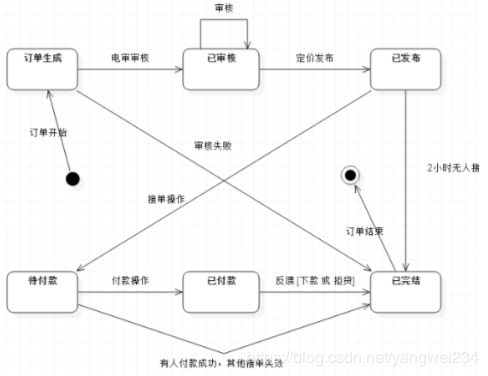
- 问题分析:这类代码难以应对变化,在添加一种状态时,我们需要手动添加if/else,在添加一种功能时, 要对所有的状态进行判断。因此代码会变得越 来越臃肿,并且一旦没有处理某个状态,便会 发生极其严重的BUG,难以维护。
解释器设计模式
单例设计模式
- 单例设计模式一共有几种实现方式?请分别用代码实现,并说明各个实现方式的优点和缺点?
- 单例设计模式一共有8种写法:饿汉式两种、懒汉式三种、双重检查、静态内部类、枚举。
设计模式的重要性
- 软件工程中,设计模式(design pattern)是对软件设计中普遍存在(反复出现)的各种问题,所提出的解决方案。这个术语是由埃里希·伽玛(Erich Gamma)等人在1990年代从建筑设计领域引入到计算机科学的。
- 大厦 VS 简易房:

- 拿实际工作经历来说,当一个项目开发完后,如果客户提出增新功能,怎么办?
- 如果项目开发完后,原来程序员离职,你接手维护该项目怎么办? (维护性[可读性、规范性])。
- 目前程序员门槛越来越高,一线IT公司(大厂),都会问你在实际项目中使用过什么设计模式,怎样使用的,解决了什么问题。
- 设计模式在软件中哪里?面向对象(oo)=>功能模块[设计模式+算法(数据结构)]=>框架[使用到多种设计模式]=>架构 [服务器集群]
- 如果想成为合格软件工程师,那就花时间来研究下设计模式是非常必要的。
设计模式七大原则
设计模式的目的
编写软件过程中,程序员面临着来自 耦合性、内聚性以及可维护性、可扩展性、重用性、灵活性 等多方面的挑战,设计模式是为了让程序(软件),具有更好的:
- 代码重用性:相同功能的代码,不用多次编写
- 可读性:编程规范性,便于其他程序员的阅读和理解
- 可扩展性:当需要增加新的功能时,非常的方便,称为可维护
- 可靠性:当我们增加新的功能后,对原来的功能没有影响
- 使程序呈现高内聚,低耦合的特性

设计模式七大原则
设计模式原则,其实就是程序员在编程时,应当遵守的原则,也是各种设计模式的基础(即:设计模式为什么这样设计的依据)
- 单一职责原则
- 接口隔离原则
- 依赖倒转(倒置)原则
- 里氏替换原则
- 开闭原则
- 迪米特法则
- 合成复用原则
单一职责原则
基本介绍
对类来说的,即一个类应该只负责一项职责。如类A负责两个不同职责:职责1、职责2。当职责1需求变更而改变A时,可能造成职责2执行错误,所以需要将类A的粒度分解为A1,A2。
应用实例
/**
* 单一职责原则
*
* @author yangwei
* @date 2020-06-25 21:42
*/
public class SingleResponsibilityCase {
/**
* 方式一:违反了单一职责原则
* 解决方案:根据交通工具的不同,分解成不同的类
*/
static class VehicleUtil {
static void run(String vehicle) {
System.out.println(vehicle + " 在公路上跑...");
}
}
/**
* 方式二:遵循单一职责原则,即将类分解,同时修改客户端
*/
static class RoadVehicleUtil {
static void run(String vehicle) {
System.out.println(vehicle + " 在公路上跑...");
}
}
static class AirVehicleUtil {
static void run(String vehicle) {
System.out.println(vehicle + " 在天空中飞行...");
}
}
/**
* 方式三:没有对原有的类做大的修改,在类上没有遵循单一职责原则,但是在方法上遵循单一职责原则
*/
static class VehicleUtil2 {
static void run(String vehicle) {
System.out.println(vehicle + " 在公路上跑...");
}
static void runAir(String vehicle) {
System.out.println(vehicle + " 在天空中飞行...");
}
static void runWater(String vehicle) {
System.out.println(vehicle + " 在水中运行...");
}
}
public static void main(String[] args) {
System.out.println("方式一:");
VehicleUtil.run("汽车");
VehicleUtil.run("摩托车");
VehicleUtil.run("飞机");
System.out.println("方式二:");
RoadVehicleUtil.run("汽车");
RoadVehicleUtil.run("摩托车");
AirVehicleUtil.run("飞机");
System.out.println("方式三:");
VehicleUtil2.run("汽车");
VehicleUtil2.runWater("轮船");
VehicleUtil2.runAir("飞机");
}
}
单一职责原则注意事项和细节
- 降低类的复杂度,一个类只负责一项职责。
- 提高类的可读性,可维护性。
- 降低变更引起的风险。
- 通常情况下,我们应当遵守单一职责原则,只有逻辑足够简单,才可以在代码级违反单一职责原则;只有类中方法数量足够少,可以在方法级别保持单一职责原则。
接口隔离原则
基本介绍
- 客户端不应该依赖它不需要的接口,即一个类对另一个类的依赖应该建立在最小的接口上,看下图:
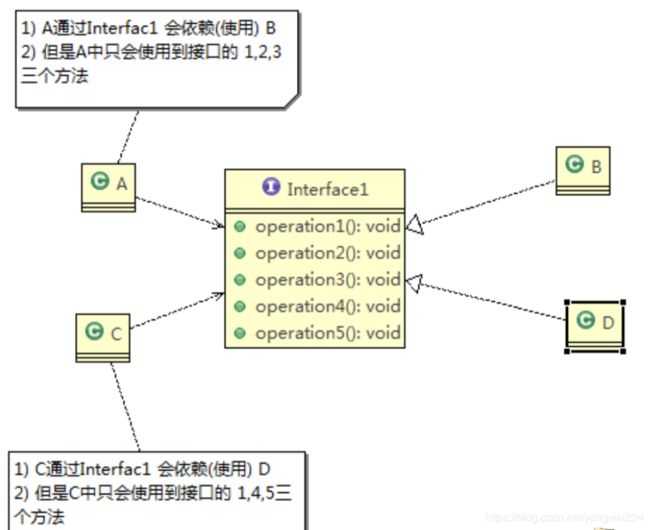
- 类A通过接口Interface1依赖类B,类C通过 接口Interface1依赖类D,如果接口 Interface1对于类A和类C来说不是最小接口,那么类B和类D必须去实现他们不需要的方 法。
- 按隔离原则应当这样处理:将接口Interface1拆分为独立的几个接口, 类A和类C分别与他们需要的接口建立依赖关系,也就是采用接口隔离原则。
应用实例
public class InterfaceSegregationCase {
interface Interface1 {
void operation1();
}
interface Interface2 {
void operation2();
void operation3();
}
interface Interface3 {
void operation4();
void operation5();
}
static class B implements Interface1, Interface2 {
public void operation1() {
System.out.println("B 实现了 operation1");
}
public void operation2() {
System.out.println("B 实现了 operation2");
}
public void operation3() {
System.out.println("B 实现了 operation3");
}
}
static class D implements Interface1, Interface3 {
public void operation1() {
System.out.println("D 实现了 operation1");
}
public void operation4() {
System.out.println("D 实现了 operation4");
}
public void operation5() {
System.out.println("D 实现了 operation5");
}
}
static class A {
void depend1(Interface1 i) {
i.operation1();
}
void depend2(Interface2 i) {
i.operation2();
}
void depend3(Interface2 i) {
i.operation3();
}
}
static class C {
void depend1(Interface1 i) {
i.operation1();
}
void depend4(Interface3 i) {
i.operation4();
}
void depend5(Interface3 i) {
i.operation5();
}
}
public static void main(String[] args) {
A a = new A();
// A 类通过接口去依赖 B 类
a.depend1(new B());
a.depend2(new B());
a.depend3(new B());
C c = new C();
// C 类通过接口去依赖 D 类
c.depend1(new D());
c.depend4(new D());
c.depend5(new D());
}
}
应传统方法的问题和使用接口隔离原则改进
依赖倒转原则
基本介绍
- 高层模块不应该依赖低层模块,二者都应该依赖其抽象。
- 抽象不应该依赖细节,细节应该依赖抽象。
- 依赖倒转(倒置)的中心思想是面向接口编程。
- 依赖倒转原则是基于这样的设计理念:相对于细节的多变性,抽象的东西要稳定的 多。以抽象为基础搭建的架构比以细节为基础的架构要稳定的多。在java中,抽象 指的是接口或抽象类,细节就是具体的实现类。
- 使用接口或抽象类的目的是制定好规范,而不涉及任何具体的操作,把展现细节的 任务交给他们的实现类去完成。
应用实例
public class DependenceInversionCase {
//region -- 方式一
// /**
// * 方式一
// * 优点:简单
// * 缺点:如果我们通过 微信、短信 等获取,则需要新增类,同时Person类也需要增加相应的接收方法
// */
// static class Email {
// String getInfo() {
// return "电子邮件信息:Hello World";
// }
// }
// static class Person {
// void receive(Email email) {
// System.out.println(email.getInfo());
// }
// }
//endregion
//region
/**
* 方式二
* 引入一个抽象的接口 IReceiver, 表示接收者, 这样 Person 类与接口 IReceiver 发生依赖
* 因为 Email, WeiXin 等等属于接收的范围,他们各自实现 IReceiver 接口就可以了,这样我们就符号依赖倒转原则
*/
interface IReceiver {
String getInfo();
}
static class Email implements IReceiver {
public String getInfo() {
return "电子邮件信息:Hello World";
}
}
static class WeChat implements IReceiver {
public String getInfo() {
return "微信信息:来红包啦!";
}
}
static class Person {
// 这里是对接口的依赖
void receive(IReceiver receiver) {
System.out.println(receiver.getInfo());
}
}
//endregion
public static void main(String[] args) {
Person person = new Person();
person.receive(new Email());
person.receive(new WeChat());
}
}
依赖关系传递的三种方式
- 接口传递
- 构造方法传递
- setter方式传递
public class DependencyPass {
public static void main(String[] args) {
// // 通过接口传递实现依赖
// OpenAndClose openAndClose = new OpenAndClose();
// openAndClose.open(new ChangHong());
// // 通过构造器进行依赖传递
// OpenAndClose2 openAndClose = new OpenAndClose2(new ChangHong());
// openAndClose.open();
// 通过 setter 方法进行依赖传递
OpenAndClose3 openAndClose = new OpenAndClose3();
openAndClose.setTv(new ChangHong());
openAndClose.open();
}
}
/**
* 电视接口
*/
interface ITV {
void play();
}
/**
* 开关接口
*/
interface IOpenAndClose {
void open(ITV tv);
}
/**
* 方式 1: 通过接口传递实现依赖
*/
class ChangHong implements ITV {
public void play() {
System.out.println("长虹电视机,打开");
}
}
class OpenAndClose implements IOpenAndClose {
public void open(ITV tv) {
tv.play();
}
}
/**
* 方式 2: 通过构造方法依赖传递
*/
interface IOpenAndClose2 {
void open();
}
class OpenAndClose2 implements IOpenAndClose2 {
private ITV tv;
public OpenAndClose2(ITV tv) {
this.tv = tv;
}
public void open() {
this.tv.play();
}
}
/**
* 方式 3: 通过 setter 方法传递
*/
interface IOpenAndClose3 {
void open();
void setTv(ITV tv);
}
class OpenAndClose3 implements IOpenAndClose3 {
private ITV tv;
public void open() {
this.tv.play();
}
public void setTv(ITV tv) {
this.tv = tv;
}
}
依赖倒转原则的注意事项和细节
- 低层模块尽量都要有抽象类或接口,或者两者都有,程序稳定性更好。
- 变量的声明类型尽量是抽象类或接口, 这样我们的变量引用和实际对象间,就存在一个缓冲层,利于程序扩展和优化。
- 继承时遵循里氏替换原则
里氏替换原则
OO中的继承性的思考和说明
- 继承包含这样一层含义:父类中凡是已经实现好的方法,实际上是在设定规范和契约,虽然它不强制要求所有的子类必须遵循这些契约,但是如果子类对这些已经实现的方法任意修改,就会对整个继承体系造成破坏。
- 继承在给程序设计带来便利的同时,也带来了弊端。比如使用继承会给程序带来侵入性,程序的可移植性降低,增加对象间的耦合性,如果一个类被其他的类所继承,则当这个类需要修改时,必须考虑到所有的子类,并且父类修改后,所有涉及到子类的功能都有可能产生故障。
- 问题提出:在编程中,如何正确的使用继承? => 里氏替换原则
基本介绍
- 里氏替换原则(Liskov Substitution Principle)在1988年,由麻省理工学院的以为姓里的女士提出的。
- 如果对每个类型为T1的对象o1,都有类型为T2的对象o2,使得以T1定义的所有程序在所有的对象o1都代换成o2时,程序P的行为没有发生变化,那么类型T2是类型T1的子类型。换句话说,所有引用基类的地方必须能透明地使用其子类的对象。
- 在使用继承时,遵循里氏替换原则,在子类中尽量不要重写父类的方法。
- 里氏替换原则告诉我们,继承实际上让两个类耦合性增强了,在适当的情况下,可以通过聚合、组合、依赖 来解决问题。
一个程序引出的问题和思考
public class LiskovSubstitutionCase {
public static void main(String[] args) {
A a = new A();
System.out.println("11-3=" + a.func1(11, 3));
System.out.println("1-8=" + a.func1(1, 8));
System.out.println("-----------------------");
B b = new B();
System.out.println("11-3=" + b.func1(11, 3));
System.out.println("1-8=" + b.func1(1, 8));
System.out.println("11+3+9=" + b.func2(11, 3));
}
}
class A {
public int func1(int num1, int num2) { return num1 - num2; }
}
class B extends A {
@Override
public int func1(int a, int b) { return a + b; }
public int func2(int a, int b) { return func1(a, b) + 9; }
}
//结果输出
//11-3=8
//1-8=-7
//-----------------------
//11-3=14
//1-8=9
//11+3+9=23
- 我们发现原来运行正常的相减功能发生了错误。原因就是类B无意中重写了父类的方法,造成原有功能出现错误。在实际编程中,我们常常会通过重写父类的方法完成新的功能,这样写起来虽然简单,但整个继承体系的复用性会比较差。特别是运行多态比较频繁的时候.
- 通用的做法是:原来的父类和子类都继承一个更通俗的基类,原有的继承关系去掉,采用依赖、聚合、组合等关系代替。
方案改进
class Base {}
class A extends Base {
public int func1(int num1, int num2) { return num1 - num2; }
}
class B extends Base {
// 如果B需要使用A类的方法,使用组合关系
private A a = new A();
public int func1(int a, int b) { return a + b; }
public int func2(int a, int b) { return func1(a, b) + 9; }
public int func3(int a, int b) { return this.a.func1(a, b); }
}
public class LiskovSubstitutionCase {
public static void main(String[] args) {
B b = new B();
// System.out.println("11-3=" + b.func1(11, 3));
// System.out.println("1-8=" + b.func1(1, 8));
// System.out.println("11+3+9=" + b.func2(11, 3));
// 因为B不在集成A类,因此调用者不会再用func1来求减法,而是用func3
System.out.println("11-3=" + b.func3(11, 3));
System.out.println("1-8=" + b.func3(1, 8));
System.out.println("11+3+9=" + b.func2(11, 3));
}
}
开闭原则OCP
基本介绍
- 开闭原则(Open Closed Principle)是编程中最基础、最重要的设计原则。
- 一个软件实体如类,模块和函数应该对扩展开放(对提供方),对修改关闭(对使用方)。用抽象构建框架,用实现扩展细节。
- 当软件需要变化时,尽量通过扩展软件实体的行为来实现变化,而不是通过修改已有的代码来实现变化。
- 编程中遵循其它原则,以及使用设计模式的目的就是遵循开闭原则。
看一段代码
public class OpenClosedCase {
public static void main(String[] args) {
GraphicEditor graphicEditor = new GraphicEditor();
graphicEditor.drawShape(new Rectangle());
graphicEditor.drawShape(new Circle());
graphicEditor.drawShape(new Triangle());
}
}
class GraphicEditor {
public void drawShape(Shape s) {
if (s.type == 1) {
drawRectangle(s);
} else if (s.type == 2) {
drawCircle(s);
} else if (s.type == 3) {
// 这里需要改动
drawTriangle(s);
}
}
private void drawRectangle(Shape r) {
System.out.println("绘制矩形");
}
private void drawCircle(Shape r) {
System.out.println("绘制圆形");
}
/**
* 这里也需要新增方法
*/
private void drawTriangle(Shape r) {
System.out.println("绘制三角形");
}
}
class Shape {
int type;
}
class Rectangle extends Shape {
Rectangle() {
super.type = 1;
}
}
class Circle extends Shape {
Circle() {
super.type = 2;
}
}
/**
* 新增画三角形
*/
class Triangle extends Shape {
Triangle() {
super.type = 3;
}
}
- 这种方式的优点是比较好理解,简单易操作。缺点是违反了设计模式的ocp原则,即对扩展开放(提供方),对修改关闭(使用方)。即当我们给类增加新功能的时候,尽量不修改代码,或者尽可能少修改代码。比如我们这时要新增加一个图形种类三角形,我们需要做如下修改,修改的地方较多。
方案改进
- 思路:把创建Shape类做成抽象类,并提供一个抽象的draw方法,让子类去实现即可,这样我们有新的图形种类时,只需要让新的图形类继承Shape,并实现draw方法即可,使用方的代码就不需要修 -> 满足了开闭原则
public class OpenClosedCase {
public static void main(String[] args) {
GraphicEditor graphicEditor = new GraphicEditor();
graphicEditor.drawShape(new Rectangle());
graphicEditor.drawShape(new Circle());
graphicEditor.drawShape(new Triangle());
}
}
/**
* 改进方案:
*/
abstract class Shape {
int type;
abstract void draw();
}
class Rectangle extends Shape {
Rectangle() {
super.type = 1;
}
@Override
public void draw() {
System.out.println("绘制矩形");
}
}
class Circle extends Shape {
Circle() {
super.type = 2;
}
@Override
public void draw() {
System.out.println("绘制圆形");
}
}
class Triangle extends Shape {
Triangle() {
super.type = 3;
}
@Override
public void draw() {
System.out.println("绘制三角形");
}
}
class GraphicEditor {
public void drawShape(Shape s) {
s.draw();
}
}
迪米特法则
基本介绍
- 一个对象应该对其他对象保持最少的了解,类与类关系越密切,耦合度越大。
- 迪米特法则(Demeter Principle)又叫最少知道原则,即一个类对自己依赖的类知道的越少越好。也就是说,对于被依赖的类不管多么复杂,都尽量将逻辑封装在类的内部。对外除了提供的public 方法,不对外泄露任何信息。
- 迪米特法则还有个更简单的定义:只与直接的朋友通信。
- 直接的朋友:每个对象都会与其他对象有耦合关系,只要两个对象之间有耦合关系,我们就说这两个对象之间是朋友关系。耦合的方式很多,依赖,关联,组合,聚合等。其中,我们称出现成员变量,方法参数,方法返回值中的类为直接的朋友,而出现在局部变量中的类不是直接的朋友。也就是说,陌生的类最好不要以局部变量的形式出现在类的内部。
应用实例
- 需求:有一个学校,下属有各个学院和总部,现要求打印出学校总部员工ID和学院员工的id。
- 代码实现:
public class DemeterCase {
public static void main(String[] args) {
SchoolManager schoolManager = new SchoolManager();
schoolManager.printAllEmployee(new CollegeManager());
}
}
/**
* 学校总部员工
*/
class Employee {
private String id;
public void setId(String id) {
this.id = id;
}
public String getId() {
return id;
}
}
/**
* 学校学院员工
*/
class CollegeEmployee {
private String id;
public void setId(String id) {
this.id = id;
}
public String getId() {
return id;
}
}
/**
* 管理学校学院员工的类
*/
class CollegeManager {
public List<CollegeEmployee> getAllEmployee() {
List<CollegeEmployee> list = new ArrayList<CollegeEmployee>();
for (int i = 0; i < 10; i++) {
CollegeEmployee emp = new CollegeEmployee();
emp.setId("学校学院员工 id= " + i);
list.add(emp);
}
return list;
}
}
/**
* 管理学校总部员工的类
* 分析:SchoolManager 类的直接朋友有哪些【Employee、CollegeManager】
* 但是 CollegeEmployee 类并不是 SchoolManager 类的直接朋友,这样就违背了迪米特法则
*/
class SchoolManager {
public List<Employee> getAllEmployee() {
List<Employee> list = new ArrayList<Employee>();
for (int i = 0; i < 5; i++) {
Employee emp = new Employee();
emp.setId("学校总部员工 id= " + i);
list.add(emp);
}
return list;
}
void printAllEmployee(CollegeManager sub) {
List<CollegeEmployee> list1 = sub.getAllEmployee();
System.out.println("------------学校学院员工------------");
for (CollegeEmployee e : list1) {
System.out.println(e.getId());
}
List<Employee> list2 = this.getAllEmployee();
System.out.println("------------学校总部员工------------");
for (Employee e : list2) {
System.out.println(e.getId());
}
}
}
迪米特法则注意事项和细节
- 迪米特法则的核心是降低类之间的耦合。
- 但是注意:由于每个类都减少了不必要的依赖,因此迪米特法则只是要求降低类间(对象间)耦合关系, 并不是要求完全没有依赖关系
合成复用原则
基本介绍
- 原则是尽量使用合成/聚合的方式,而不是使用继承。
应用实例
设计原则核心思想
- 找出应用中可能需要变化之处,把它们独立出来,不要和那些不需要变化的代码混在一起。
- 针对接口编程,而不是针对实现编程。
- 为了交互对象之间的松耦合设计而努力。
UML类图
UML基本介绍
- UML——Unified modeling language UML(统一建模语言),是一种用于软件系统分析和设计的语言工具,它用于帮助软件开发人员进行思考和记录思路的结果。
- UML本身是一套符号的规定,就像数学符号和化学符号一样,这些符号用于描述软件模型中的各个元素和他们之间的关系,比如类、接口、实现、泛化、依赖、组合、聚合等,如图:
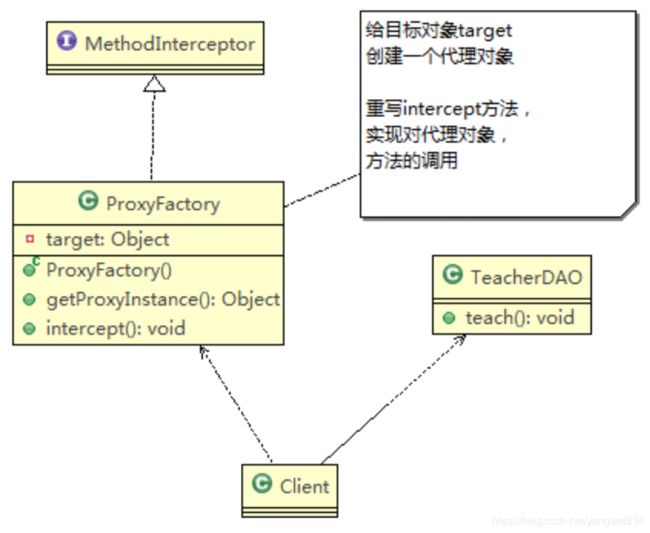
- 使用UML来建模,常用的工具有 Rational Rose , 也可以使用一些插件来建模。
UML图
画UML图与写文章差不多,都是把自己的思想描述给别人看,关键在于思路和条理,UML图分类:
- ① 用例图(usecase)
- ② 静态结构图:类图、对象图、包图、组件图、部署图
- ③ 动态行为图:交互图(时序图与协作图)、状态图、活动图
- 类图是描述类与类之间的关系的,是UML图中最核心的
UML类图
- 用于描述系统中的类(对象)本身的组成和类(对象)之间的各种静态关系。
- 类之间的关系:依赖、泛化(继承)、实现、关联、聚合与组合
- 类图简单举例:
public class Person{ //代码形式->类图 private Integer id;
private String name;
public void setName(String name){
this.name = name;
}
public String getName(){
return name;
}
}
类图—依赖关系(Dependence)
- 只要是在类中用到了对方,那么他们之间就存在依赖关系。如果没有对方,连编绎都通过不了。
- 案例:
public class PersonServiceBean {
private PersonDao personDao;//类
public void save(Person person){}
public IDCard getIDCard(Integer personid){}
public void modify(){
Department department = new Department();
}
}
public class PersonDao{}
public class IDCard{}
public class Person{}
public class Department{}
- 小结
* 类中用到了对方
* 如果是类的成员属性
* 如果是方法的返回类型
* 是方法接收的参数类型
* 方法中使用到
类图—泛化关系(generalization)
类图—实现关系(Implementation)
类图—关联关系(Association)
- 关联关系实际上就是类与类之间的联系,他是依赖关系的特例
- 关联具有导航性:即双向关系或单向关系
- 关系具有多重性:如“1”(表示有且仅有一个),“0…”(表示0个或者多个),“0,1”(表示0个或者一个),“n…m”(表示n到 m个都可以),“m…*”(表示至少m个)
- ① 单向一对一关系
- ② 双向一对一关系
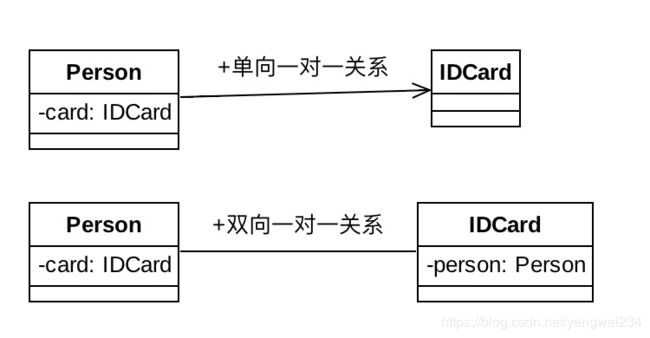
类图—聚合关系(Aggregation)
- 聚合关系(Aggregation)表示的是整体和部分的关系,整体与部分可以分开。聚合关系是关联关系的特例,所以他具有关联的导航性与多重性。
- 如:一台电脑由键盘(keyboard)、显示器(monitor),鼠标等组成;组成电脑的各个配件是可以从电脑上分离出来的,使用带空心菱形的实线来表示:
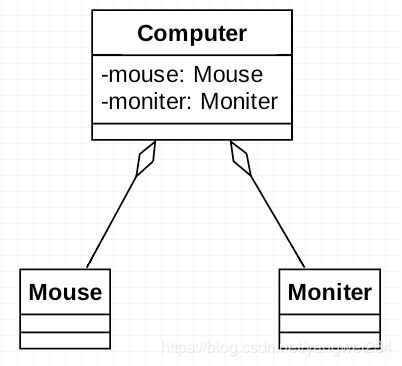
- 如果我们让 Mouse、Monitor 和 Computer 是不可分离的,则升级为组合关系。
类图—组合关系(Composition)
- 组合关系:也是整体与部分的关系,但是整体与部分不可以分开。
- 再看一个案例:在程序中我们定义实体 Person 与 IDCard、Head,那么 Head 和 Person 就是 组合,IDCard 和 Person 就是聚合。
- 但是如果在程序中 Person 实体中定义了对 IDCard 进行级联删除,即删除 Person 时连同 IDCard 一起删除,那么 IDCard 和 Person 就是组合了。

Java设计模式概述
掌握设计模式的层次
- 第1层:刚开始学编程不久,听说过什么是设计模式。
- 第2层:有很长时间的编程经验,自己写了很多代码,其中用到了设计模式,但是自己却不知道。
- 第3层:学习过了设计模式,发现自己已经在使用了,并且发现了一些新的模式挺好用的。
- 第4层:阅读了很多别人写的源码和框架,在其中看到别人设计模式,并且能够领会设计模式的精妙和带来的好处。
- 第5层:代码写着写着,自己都没有意识到使用了设计模式,并且熟练的写了出来。
设计模式介绍
- 设计模式是程序员在面对同类软件工程设计问题所总结出来的有用的经验,模式不是代码,而是某类问题的通用解决方案,设计模式(Design pattern)代表了最佳的实践。这些解决方案是众多软件开发人员经过相当长的一段时间的试验和错误总结出来的。
- 设计模式的本质提高软件的维护性,通用性和扩展性,并降低软件的复杂度。
- <<设计模式>>是经典的书,作者是ErichGamma、RichardHelm、Ralph Johnson 和 John Vlissides Design(俗称 “四人组 GOF”)。
- 设计模式并不局限于某种语言,java、php、c++ 都有设计模式。
设计模式类型
设计模式分为三种类型,共23种。
- 创建型模式:单例模式、抽象工厂模式、原型模式、建造者模式、工厂模式。
- 结构型模式:适配器模式、桥接模式、装饰模式、组合模式、外观模式、享元模式、代理模式。
- 行为型模式:模版方法模式、命令模式、访问者模式、迭代器模式、观察者模式、中介者模式、备忘录模式、解释器模式(Interpreter模式)、状态模式、策略模式、职责链模式(责任链模式)。
23种设计模式
创建型模式
单例模式
- 所谓类的单例设计模式,就是采取一定的方法保证在整个的软件系统中,对某个类只能存在一个对象实例,并且该类只提供一个取得其对象实例的方法(静态方法)。
- 比如Hibernate的SessionFactory,它充当数据存储源的代理,并负责创建Session对象。SessionFactory并不是轻量级的,一般情况下,一个项目通常只需要一个SessionFactory就够,这是就会使用到单例模式。
- UML类图:
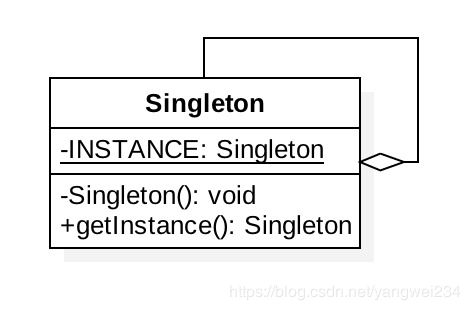
单例设计模式八种方式
- 饿汉式(静态常量)
- 饿汉式(静态代码块)
- 懒汉式(线程不安全)
- 懒汉式(线程安全,同步方法)
- 懒汉式(线程安全,同步代码块)
- 双重检查
- 静态内部类
- 枚举
饿汉式(静态常量)
public class SingletonCase01 {
public static void main(String[] args) {
Singleton1 instance1 = Singleton1.getInstance();
Singleton1 instance2 = Singleton1.getInstance();
System.out.println(instance1 == instance2);
}
}
class Singleton1 {
/**
* 1、构造器私有化(防止 new)
*/
private Singleton1(){}
/**
* 2、类的内部创建对象
*/
private static final Singleton1 INSTANCE = new Singleton1();
/**
* 3、向外暴露一个静态的公共方法
*/
public static Singleton1 getInstance() {
return INSTANCE;
}
}
- 优点:这种写法比较简单,就是在类装载的时候就完成实例化。避免了线程同步问题。
- 缺点:在类装载的时候就完成实例化,没有达到 Lazy Loading 的效果。如果从始至终从未使用过这个实例,则会造成内存的浪费。
- 这种方式基于classloder机制避免了多线程的同步问题,不过,instance在类装载时就实例化,在单例模式中大多数都是调用getInstance方法, 但是导致类装载的原因有很多种,因此不能确定有其他的方式(或者其他的静态方法)导致类装载,这时候初始化instance就没有达到 lazy loading 的效果
- 结论:这种单例模式可用,可能造成内存浪费。
饿汉式(静态代码块)
public class SingletonCase02 {
public static void main(String[] args) {
Singleton2 instance1 = Singleton2.getInstance();
Singleton2 instance2 = Singleton2.getInstance();
System.out.println(instance1 == instance2);
}
}
class Singleton2 {
/**
* 1、构造器私有化(防止 new)
*/
private Singleton2(){}
/**
* 2、类的内部创建对象:在静态代码块执行时,创建单例对象
*/
private static Singleton2 INSTANCE;
static {
INSTANCE = new Singleton2();
}
/**
* 3、向外暴露一个静态的公共方法
*/
public static Singleton2 getInstance() {
return INSTANCE;
}
}
- 这种方式和上面的方式其实类似,只不过将类实例化的过程放在了静态代码块中,也是在类装载的时候,就执行静态代码块中的代码,初始化类的实例。优缺点和上面是一样的。
- 结论:这种单例模式可用,但是可能造成内存浪费。
懒汉式(线程不安全)
public class SingletonCase03 {
public static void main(String[] args) {
// Singleton3 instance1 = Singleton3.getInstance();
// Singleton3 instance2 = Singleton3.getInstance();
// System.out.println(instance1 == instance2);
for (int i = 0; i < 50; i++) {
new Thread(() -> System.out.println(Singleton3.getInstance().hashCode())).start();
}
}
}
class Singleton3 {
private Singleton3(){}
private static Singleton3 INSTANCE;
/**
* 提供一个静态的公有方法,当使用到该方法时,才去创建 instance
*/
public static Singleton3 getInstance() {
if (INSTANCE == null) {
INSTANCE = new Singleton3();
}
return INSTANCE;
}
}
- 起到了Lazy Loading的效果,但是只能在单线程下使用。
- 如果在多线程下,一个线程进入了if (singleton == null)判断语句块,还未来得及往下执行,另一个线程也通过了这个判断语句,这时便会产生多个实例。所以在多线程环境下不可使用这种方式。
- 结论:在实际开发中,不要使用这种方式。
懒汉式(线程安全,同步方法)
public class SingletonCase04 {
public static void main(String[] args) {
for (int i = 0; i < 50; i++) {
new Thread(() -> System.out.println(Singleton4.getInstance().hashCode())).start();
}
}
}
class Singleton4 {
private Singleton4(){}
private static Singleton4 INSTANCE;
/**
* 加synchronized,解决多线程不安全问题
*/
public static synchronized Singleton4 getInstance() {
if (INSTANCE == null) {
INSTANCE = new Singleton4();
}
return INSTANCE;
}
}
- 解决了线程不安全问题。
- 但是效率太低了,每个线程在想获得类的实例时候,执行getInstance()方法都要进行同步。而其实这个方法只执行一次实例化代码就够了,后面的想获得该类实例,直接return就行了。方法进行同步效率太低。
- 结论:在实际开发中,不推荐使用这种方式。
懒汉式(线程不安全,同步代码块)
public class SingletonCase05 {
public static void main(String[] args) {
for (int i = 0; i < 50; i++) {
new Thread(() -> System.out.println(Singleton5.getInstance().hashCode())).start();
}
}
}
class Singleton5 {
private Singleton5(){}
private static Singleton5 INSTANCE;
/**
* 加synchronized,解决多线程不安全问题
*/
public static Singleton5 getInstance() {
if (INSTANCE == null) {
synchronized (Singleton5.class) {
INSTANCE = new Singleton5();
}
}
return INSTANCE;
}
}
- 这种方式,本意是想对第四种实现方式的改进,因为前面同步方法效率太低,改为同步产生实例化的的代码块。
- 但是这种同步并不能起到线程同步的作用。跟第3种实现方式遇到的情形一致,假如一个线程进入了if (singleton == null)判断语句块,还未来得及往下执行,另一个线程也通过了这个判断语句,这时便会产生多个实例。
- 结论:在实际开发中,不能使用这种方式
双重检查单例
public class SingletonCase06 {
public static void main(String[] args) {
for (int i = 0; i < 50; i++) {
new Thread(() -> System.out.println(Singleton6.getInstance().hashCode())).start();
}
}
}
class Singleton6 {
private Singleton6(){}
/**
* 这里的 volatile 一定不能够少,防止获取到半初始化状态的实例
*/
private static volatile Singleton6 INSTANCE;
/**
* 加synchronized,解决多线程不安全问题
*/
public static Singleton6 getInstance() {
if (INSTANCE == null) {
synchronized (Singleton6.class) {
if (INSTANCE == null) {
INSTANCE = new Singleton6();
}
}
}
return INSTANCE;
}
}
- Double-Check概念是多线程开发中常使用到的,如代码中所示,我们进行了两次if (singleton == null)检查,这样就可以保证线程安全了。
- 这样,实例化代码只用执行一次,后面再次访问时,判断if (singleton == null),直接return实例化对象,也避免的反复进行方法同步。
- 线程安全、延迟加载、效率较高。
- 结论:在实际开发中,推荐使用这种单例设计模式。
静态内部类单例
public class SingletonCase07 {
public static void main(String[] args) {
for (int i = 0; i < 50; i++) {
new Thread(() -> System.out.println(Singleton7.getInstance().hashCode())).start();
}
}
}
class Singleton7 {
private Singleton7() {}
/**
* 使用静态内部类,在Singleton7被加载时,不会被加载
* 只有在getInstance()时被加载,并且加载时是线程安全的
*/
private static class SingletonInstance {
private static final Singleton7 INSTANCE = new Singleton7();
}
public static Singleton7 getInstance() {
return SingletonInstance.INSTANCE;
}
}
- 这种方式采用了类装载的机制来保证初始化实例时只有一个线程。
- 静态内部类方式在Singleton类被装载时并不会立即实例化,而是在需要实例化时,调用getInstance方法,才会装载SingletonInstance类,从而完成Singleton的实例化。
- 类的静态属性只会在第一次加载类的时候初始化,所以在这里,JVM帮助我们保证了线程的安全性,在类进行初始化时,别的线程是无法进入的。
- 优点:避免了线程不安全,利用静态内部类特点实现延迟加载,效率高。
- 结论:推荐使用。
枚举单例
public class SingletonCase08 {
public static void main(String[] args) {
for (int i = 0; i < 50; i++) {
new Thread(() -> System.out.println(Singleton8.getInstance().hashCode())).start();
}
}
}
class Singleton8 {
private Singleton8() {}
static enum SingletonInstance {
INSTANCE;
private Singleton8 singleton8;
// 私有化枚举的构造函数
private SingletonInstance() {
singleton8 = new Singleton8();
}
public Singleton8 getInstance() {
return singleton8;
}
}
public static Singleton8 getInstance() {
return SingletonInstance.INSTANCE.getInstance();
}
}
- 这借助JDK1.5中添加的枚举来实现单例模式。不仅能避免多线程同步问题,而且还能防止反序列化重新创建新的对象。
- 这种方式是Effective Java作者Josh Bloch 提倡的方式。
- 结论:推荐使用。
单例模式在JDK 应用的源码分析
单例模式注意事项和细节说明
- 单例模式保证了系统内存中该类只存在一个对象,节省了系统资源,对于一些需要频繁创建销毁的对象,使用单例模式可以提高系统性能。
- 当想实例化一个单例类的时候,必须要记住使用相应的获取对象的方法,而不是使用new。
- 单例模式使用的场景:需要频繁的进行创建和销毁的对象、创建对象时耗时过多或耗费资源过多(即:重量级对象),但又经常用到的对象、工具类对象、频繁访问数据库或文件的对象(比如数据源、session工厂等)。
工厂设计模式
- 看一个披萨的项目:要便于披萨种类的扩展,要便于维护。
- 披萨的种类很多(比如 GreekPizz、CheesePizz 等),披萨的制作有 prepare、bake、cut、box,完成披萨店订购功能。
使用传统的方式来完成
/**
* 定义一个披萨的抽象类
*/
public abstract class Pizza {
/**
* 披萨名字
*/
protected String name;
/**
* 原材料准备
*/
public abstract void prepare();
public void bake(){
System.out.println(name + " baking;");
}
public void cut() {
System.out.println(name + " cutting;");
}
public void box() {
System.out.println(name + " boxing;");
}
public Pizza(String name) {
this.name = name;
}
}
// 奶酪披萨
public class CheesePizza extends Pizza {
public CheesePizza() {
super("奶酪披萨");
}
@Override
public void prepare() {
System.out.println("给制作奶酪披萨准备原材料");
}
}
// 希腊披萨
public class GreekPizza extends Pizza {
public GreekPizza() {
super("希腊披萨");
}
@Override
public void prepare() {
System.out.println("给希腊披萨准备原材料");
}
}
/**
* 披萨订购
*/
public class PizzaOrder {
Pizza pizza = null;
public PizzaOrder() {
String orderType = "";
do {
orderType = getType();
if (orderType.equals("greek")) {
pizza = new GreekPizza();
} else if (orderType.equals("cheese")) {
pizza = new CheesePizza();
} else {
break;
}
// 输出披萨制作过程
pizza.prepare();
pizza.bake();
pizza.cut();
pizza.box();
} while (true);
}
/**
* 获取客户希望订购披萨的种类
*/
private String getType() {
try {
BufferedReader in = new BufferedReader(new InputStreamReader(System.in));
System.out.println("input pizza type: ");
return in.readLine();
} catch (IOException e) {
System.out.println(e.getMessage());
return "";
}
}
}
// 披萨店
public class PizzaStore {
public static void main(String[] args) {
new PizzaOrder();
}
}
- 优点是比较好理解,简单易操作。
- 缺点是违反了设计模式的ocp原则,即对扩展开放,对修改关闭。即当我们给类增加新功能的时候,尽量不修改代码,或者尽可能少修改代码。
- 比如我们这时要新增加一个Pizza的种类(Pepper披萨),我们就需要修改代码。
- 改进:把创建Pizza对象封装到一个类中,这样我们有新的Pizza种类时,只需要修改该类就可,其它有创建到Pizza对象的代码就不需要修改了-> 简单工厂模式。
简单工厂模式
基本介绍
- 简单工厂模式是属于创建型模式,是工厂模式的一种。简单工厂模式是由一个工厂对象决定创建出哪一种产品类的实例。简单工厂模式是工厂模式家族中最简单实用的模式。
- 简单工厂模式:定义了一个创建对象的类,由这个类来封装实例化对象的行为。
- 在软件开发中,当我们会用到大量的创建某种、某类或者某批对象时,就会使用到工厂模式。
- UML类图:
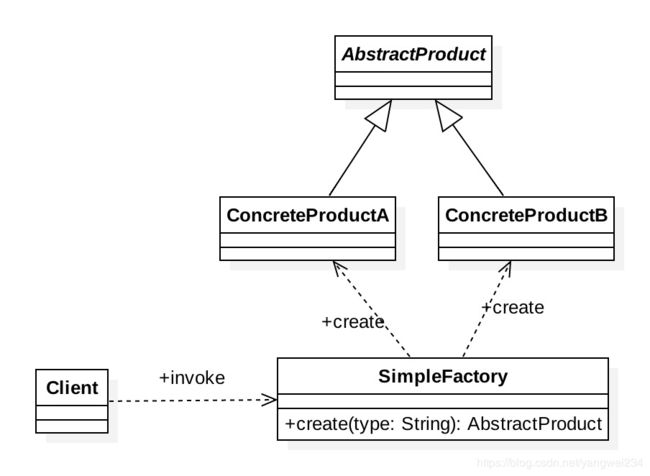
代码实现
public class SimpleFactory {
public Pizza createPizza(String orderType) {
Pizza pizza = null;
if (orderType.equals("greek")) {
pizza = new GreekPizza();
} else if (orderType.equals("cheese")) {
pizza = new CheesePizza();
}
if (pizza != null) {
// 输出披萨制作过程
pizza.prepare();
pizza.bake();
pizza.cut();
pizza.box();
}
return pizza;
}
}
public class PizzaOrder {
SimpleFactory simpleFactory;
public PizzaOrder(SimpleFactory simpleFactory) {
do {
this.simpleFactory = simpleFactory;
simpleFactory.createPizza(getType());
} while (true);
}
/**
* 获取客户希望订购披萨的种类
*/
private String getType() {
try {
BufferedReader in = new BufferedReader(new InputStreamReader(System.in));
System.out.println("input pizza type: ");
return in.readLine();
} catch (IOException e) {
System.out.println(e.getMessage());
return "";
}
}
}
public class PizzaStore {
public static void main(String[] args) {
new PizzaOrder(new SimpleFactory());
}
}
工厂方法模式
基本介绍
- 需求:披萨项目新的需求:客户在点披萨时,可以点不同口味的披萨,比如 北京的奶酪pizza、北京的胡椒pizza 或者是伦敦的奶酪pizza、伦敦的胡椒pizza。
- 使用简单工厂模式,创建不同的简单工厂类,比如BJPizzaSimpleFactory、LDPizzaSimpleFactory 等等。从当前这个案例来说,也是可以的,但是考虑到项目的规模,以及软件的可维护性、可扩展性并不是特别好。
- 工厂方法模式设计方案:将披萨项目的实例化功能抽象成抽象方法,在不同的口味点餐子类中具体实现。定义了一个创建对象的抽象方法,由子类决定要实例化的类,工厂方法模式将对象的实例化推迟到子类。
- UML类图:
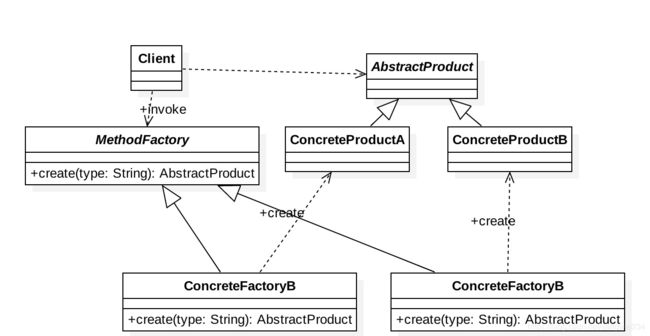
代码实现
public abstract class PizzaOrder {
public PizzaOrderFactory(String desc) {
System.out.println(desc);
do {
Pizza pizza = createPizza(getType());
if (pizza != null) {
// 输出披萨制作过程
pizza.prepare();
pizza.bake();
pizza.cut();
pizza.box();
} else {
System.out.println("没有这种披萨,订购失败");
break;
}
} while (true);
}
/**
* 交给工厂子类完成
*/
abstract Pizza createPizza(String orderType);
/**
* 获取客户希望订购披萨的种类
*/
private String getType() {
try {
BufferedReader in = new BufferedReader(new InputStreamReader(System.in));
System.out.println("input pizza type: ");
return in.readLine();
} catch (IOException e) {
System.out.println(e.getMessage());
return "";
}
}
}
public class BJPizzaOrderFactory extends PizzaOrderFactory {
BJPizzaOrderFactory() {
super("开始订购北京披萨");
}
@Override
Pizza createPizza(String orderType) {
if (orderType.equals("cheese")) {
return new BJCheesePizza();
} else if (orderType.equals("pepper")) {
return new BJPepperPizza();
}
return null;
}
}
public class LDPizzaOrderFactory extends PizzaOrderFactory {
LDPizzaOrderFactory() {
super("开始订购伦敦披萨");
}
@Override
Pizza createPizza(String orderType) {
if (orderType.equals("cheese")) {
return new LDCheesePizza();
} else if (orderType.equals("pepper")) {
return new LDPepperPizza();
}
return null;
}
}
抽象工厂模式
基本介绍
- 抽象工厂模式:定义了一个interface用于创建相关或有依赖关系的对象簇,而无需指明具体的类。
- 抽象工厂模式可以将简单工厂模式和工厂方法模式进行整合。
- 从设计层面看,抽象工厂模式就是对简单工厂模式的改进(或者称为进一步的抽象)。
- 将工厂抽象成两层,AbsFactory(抽象工厂) 和 具体实现的工厂子类。程序员可以根据创建对象类型使用对应的工厂子类。这样将单个的简单工厂类变成了工厂簇,更利于代码的维护和扩展。
- UML类图:
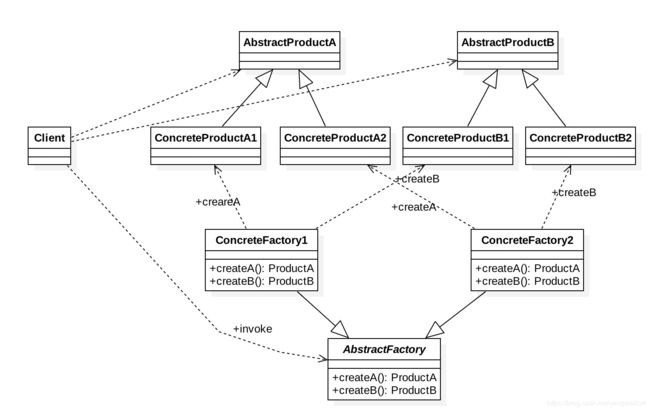
代码实现
public abstract class AbstractPizzaOrderFactory {
AbstractPizzaOrderFactory(String desc) {
System.out.println(desc);
}
abstract Pizza createPizza(String orderType);
}
public class BJPizzaOrderFactory extends AbstractPizzaOrderFactory {
BJPizzaOrderFactory() {
super("开始订购北京披萨");
}
@Override
Pizza createPizza(String orderType) {
if (orderType.equals("cheese")) {
return new BJCheesePizza();
} else if (orderType.equals("pepper")) {
return new BJPepperPizza();
}
return null;
}
}
public class LDPizzaOrderFactory extends AbstractPizzaOrderFactory {
LDPizzaOrderFactory() {
super("开始订购伦敦披萨");
}
@Override
Pizza createPizza(String orderType) {
if (orderType.equals("cheese")) {
return new LDCheesePizza();
} else if (orderType.equals("pepper")) {
return new LDPepperPizza();
}
return null;
}
}
工厂模式在JDK-Calendar 应用的源码分析
- JDK中的Calendar类中,就使用了简单工厂模式
public class JDKFactory {
public static void main(String[] args) {
Calendar cal = Calendar.getInstance();
}
}
↓↓↓↓↓
public static Calendar getInstance()
{
return createCalendar(TimeZone.getDefault(), Locale.getDefault(Locale.Category.FORMAT));
}
↓↓↓↓↓
private static Calendar createCalendar(TimeZone zone, Locale aLocale)
{
CalendarProvider provider =
LocaleProviderAdapter.getAdapter(CalendarProvider.class, aLocale)
.getCalendarProvider();
if (provider != null) {
try {
return provider.getInstance(zone, aLocale);
} catch (IllegalArgumentException iae) {
// fall back to the default instantiation
}
}
Calendar cal = null;
// 下面就是工厂模式
if (aLocale.hasExtensions()) {
String caltype = aLocale.getUnicodeLocaleType("ca");
if (caltype != null) {
switch (caltype) {
case "buddhist":
cal = new BuddhistCalendar(zone, aLocale);
break;
case "japanese":
cal = new JapaneseImperialCalendar(zone, aLocale);
break;
case "gregory":
cal = new GregorianCalendar(zone, aLocale);
break;
}
}
}
if (cal == null) {
if (aLocale.getLanguage() == "th" && aLocale.getCountry() == "TH") {
cal = new BuddhistCalendar(zone, aLocale);
} else if (aLocale.getVariant() == "JP" && aLocale.getLanguage() == "ja"
&& aLocale.getCountry() == "JP") {
cal = new JapaneseImperialCalendar(zone, aLocale);
} else {
cal = new GregorianCalendar(zone, aLocale);
}
}
return cal;
}
工厂模式小结
- 工厂模式的意义:将实例化对象的代码提取出来,放到一个类中统一管理和维护,达到和主项目的依赖关系的解耦。从而提高项目的扩展和维护性。
- 三种工厂模式:简单工厂模式、工厂方法模式、抽象工厂模式。
- 设计模式的依赖抽象原则:创建对象实例时,不要直接 new 类, 而是把这个new 类的动作放在一个工厂的方法中,并返回。有的书上说,变量不要直接持有具体类的引用。不要让类继承具体类,而是继承抽象类或者是实现interface(接口)。不要覆盖基类中已经实现的方法。
原型模式
克隆羊问题
- 现在有一只羊 Tom,姓名为Tom,年龄为1,颜色为白色,请编写程序创建和 Tom 羊,属性完全相同的10只羊。
- 传统方式解决克隆羊问题:
public class SheepCase {
public static void main(String[] args) {
// 传统方法
Sheep sheep = new Sheep("Tom", 1, "白色");
Sheep sheep2 = new Sheep(sheep.getName(), sheep.getAge(), sheep.getColor());
Sheep sheep3 = new Sheep(sheep.getName(), sheep.getAge(), sheep.getColor());
Sheep sheep4 = new Sheep(sheep.getName(), sheep.getAge(), sheep.getColor());
Sheep sheep5 = new Sheep(sheep.getName(), sheep.getAge(), sheep.getColor());
// ...
System.out.println(sheep);
System.out.println(sheep2);
System.out.println(sheep3);
System.out.println(sheep4);
System.out.println(sheep5);
}
}
class Sheep {
private String name;
private int age;
private String color;
Sheep(String name, int age, String color) {
this.name = name;
this.age = age;
this.color = color;
}
// setter、getter
}
- 优点是比较好理解,简单易操作。
- 在创建新的对象时,总是需要重新获取原始对象的属性,如果创建的对象比较复杂时,效率较低。
- 总是需要重新初始化对象,而不是动态地获得对象运行时的状态, 不够灵活。
- 改进的思路:Java中Object类是所有类的根类,Object类提供了一个clone()方法,该方法可以将一个Java对象复制一份,但是需要实现clone的Java类必须要实现一个接口Cloneable,该接口表示该类能够复制且具有复制的能力 => 原型模式。
原型模式-基本介绍
- 原型模式(Prototype模式)是指:用原型实例指定创建对象的种类,并且通过拷贝这些原型,创建新的对象。
- 原型模式是一种创建型设计模式,允许一个对象再创建另外一个可定制的对象,无需知道如何创建的细节。
- 工作原理是:通过将一个原型对象传给那个要发动创建的对象,这个要发动创建的对象通过请求原型对象拷贝它们自己来实施创建,即 对象.clone()。
- 形象的理解:孙大圣拔出猴毛,变出其它孙大圣。
- UML类图:
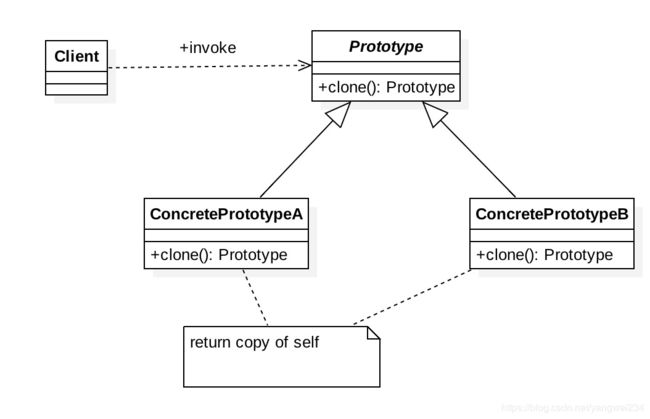
代码改进
class Sheep implements Cloneable {
private String name;
private int age;
private String color;
Sheep(String name, int age, String color) {
this.name = name;
this.age = age;
this.color = color;
}
// setter、getter
@Override
public String toString() {
return "Sheep: {name: " + name + ", age: " + age + ", color: " + color + "}";
}
@Override
protected Object clone() {
try {
Sheep sheep = (Sheep) super.clone();
return super.clone();
} catch (Exception e) {
System.out.println(e.getMessage());
}
return null;
}
public Sheep getCopy() {
return (Sheep) clone();
}
}
原型模式在Spring框架中源码分析
深入讨论-浅拷贝和深拷贝
浅拷贝的介绍
- 对于数据类型是基本数据类型的成员变量,浅拷贝会直接进行值传递,也就是将该属性值复制一份给新的对象。
- 对于数据类型是引用数据类型的成员变量,比如说成员变量是某个数组、某个类的对象等,那么浅拷贝会进行引用传递,也就是只是将该成员变量的引用值(内存地址)复制一份给新的对象。因为实际上两个对象的该成员变量都指向同一个实例。在这种情况下,在一个对象中修改该成员变量会影响到另一个对象的该成员变量值。
- 前面我们克隆羊就是浅拷贝,浅拷贝是使用默认的 clone()方法来实现。
深拷贝基本介绍
- 复制对象的所有基本数据类型的成员变量值。
- 为所有引用数据类型的成员变量申请存储空间,并复制每个引用数据类型成员变量所引用的对象,直到该对象可达的所有对象。也就是说,对象进行深拷贝要对整个对象进行拷贝。
- 深拷贝实现方式1:重写clone方法来实现深拷贝。
- 深拷贝实现方式2:通过对象序列化实现深拷贝(推荐)。
/**
* 深浅复制
*/
public class DeepShallowCopy implements Cloneable, Serializable {
private static final long serialVersionUID = 1L;
private String string;
private SerializableObject obj;
public String getString() {
return string;
}
public void setString(String string) {
this.string = string;
}
public SerializableObject getObj() {
return obj;
}
public void setObj(SerializableObject obj) {
this.obj = obj;
}
/**
* 浅复制
*/
public Object shallowClone() throws CloneNotSupportedException{
DeepShallowCopy proto = (DeepShallowCopy) super.clone();
return proto;
}
/**
* 深复制
* @throws ClassNotFoundException
*/
public Object deepClone() throws IOException, ClassNotFoundException{
// 写入当前对象的二进制流
ByteArrayOutputStream bos = new ByteArrayOutputStream();
ObjectOutputStream oos = new ObjectOutputStream(bos);
oos.writeObject(this);
// 读出二进制流产生的新对象
ByteArrayInputStream bis = new ByteArrayInputStream(bos.toByteArray());
ObjectInputStream ois = new ObjectInputStream(bis);
return ois.readObject();
}
}
class SerializableObject implements Serializable{
private static final long serialVersionUID = 1L;
}
原型模式的注意事项和细节
- 创建新的对象比较复杂时,可以利用原型模式简化对象的创建过程,同时也能够提高效率。
- 不用重新初始化对象,而是动态地获得对象运行时的状态。
- 如果原始对象发生变化(增加或者减少属性),其它克隆对象的也会发生相应的变化,无需修改代码。
- 在实现深克隆的时候可能需要比较复杂的代码。
- 缺点:需要为每一个类配备一个克隆方法,这对全新的类来说不是很难,但对已有的类进行改造时,需要修改其源代码,违背了ocp原则。
建造者模式
盖房项目需求
- 需要建房子:这一过程为打桩、砌墙、封顶,房子有各种各样的,比如普通房,高楼,别墅,各种房子的过程虽然一样,但是要求不要相同的。
- 传统方式解决盖房需求:
public abstract class AbstractHouse {
abstract void buildBasic();
abstract void buildWalls();
abstract void roofed();
public void build() {
buildBasic();
buildWalls();
roofed();
System.out.println("房子建造完成~~");
}
}
public class CommonHouse extends AbstractHouse {
@Override
void buildBasic() {
System.out.println("普通房子 打地基");
}
@Override
void buildWalls() {
System.out.println("普通房子 砌墙");
}
@Override
void roofed() {
System.out.println("普通房子 盖屋顶");
}
}
public class BuildHouseCase {
public static void main(String[] args) {
CommonHouse commonHouse = new CommonHouse();
commonHouse.build();
}
}
- 优点是比较好理解,简单易操作。
- 设计的程序结构,过于简单,没有设计缓存层对象,程序的扩展和维护不好。也就是说,这种设计方案,把产品(即房子) 和创建产品的过程(即:建房子流程) 封装在一起,耦合性增强了。
- 解决方案:将产品和产品建造过程解耦 => 建造者模式。
建造者模式基本介绍
- 建造者模式(Builder Pattern)又叫生成器模式,是一种对象构建模式。它可以将复杂对象的建造过程抽象出来(抽象类别),使这个抽象过程的不同实现方法可以构造出不同表现(属性)的对象。
- 建造者模式是一步一步创建一个复杂的对象,它允许用户只通过指定复杂对象的类型和内容就可以构建它们,用户不需要知道内部的具体构建细节。
建造者模式的四个角色
- Product(产品角色):一个具体的产品对象。
- Builder(抽象建造者):创建一个Product对象的各个部件指定的接口/抽象类。
- ConcreteBuilder(具体建造者):实现接口,构建和装配各个部件。
- Director(指挥者):构建一个使用Builder接口的对象。它主要是用于创建一个复杂的对象。它主要有两个作用,一是隔离了客户与对象的生产过程,二是负责控制产品对象的生产过程。
- UML类图:

建造者模式解决盖房需求
// 产品
public class House {
private String basic;
private String wall;
private String roofed;
// setter、getter
@Override
public String toString() {
return "House: {basic: " + basic + ", wall: " + wall + ", roofed: " + roofed + "}";
}
}
// 房子构建抽象类
public abstract class HouseBuilder {
protected House house = new House();
abstract void buildBasic();
abstract void buildWalls();
abstract void roofed();
public House getHouse() {
return house;
}
}
// 房子的具体构建者-普通房子
public class CommonHouse extends HouseBuilder {
@Override
void buildBasic() {
System.out.println("普通房子 打地基 5 米");
house.setBasic("5 米");
}
@Override
void buildWalls() {
System.out.println("普通房子 砌墙 10 厘米");
house.setWall("10 厘米");
}
@Override
void roofed() {
System.out.println("普通房子屋顶");
house.setRoofed("普通屋顶");
}
}
// 房子的具体构建者-高楼
public class HighBuildingHouse extends HouseBuilder {
@Override
void buildBasic() {
System.out.println("高楼 打地基 100 米");
house.setBasic("100 米");
}
@Override
void buildWalls() {
System.out.println("高楼 砌墙 25 厘米");
house.setWall("25 厘米");
}
@Override
void roofed() {
System.out.println("高楼屋顶");
house.setRoofed("高楼屋顶");
}
}
// 指挥者:去指定建造房子的流程
public class HouseDirector {
private HouseBuilder builder;
HouseDirector(HouseBuilder builder) {
this.builder = builder;
}
public House build() {
builder.buildBasic();
builder.buildWalls();
builder.roofed();
return builder.getHouse();
}
}
- 测试:
public class BuildHouseCase {
public static void main(String[] args) {
CommonHouse commonHouse = new CommonHouse();
HouseDirector director = new HouseDirector(commonHouse);
House house1 = director.build();
System.out.println(house1);
HighBuildingHouse highBuildingHouse = new HighBuildingHouse();
director = new HouseDirector(highBuildingHouse);
House house2 = director.build();
System.out.println(house2);
}
}
建造者模式在JDK的应用和源码分析
- java.lang.StringBuilder中的建造者模式
public class JDKBuilder {
public static void main(String[] args) {
StringBuilder sb = new StringBuilder();
sb.append("Hello, World");
System.out.println(sb);
}
}
↓↓↓↓↓
// public final class StringBuilder extends AbstractStringBuilder implements java.io.Serializable, CharSequence
@Override
public StringBuilder append(String str) {
super.append(str);
return this;
}
↓↓↓↓↓
// abstract class AbstractStringBuilder implements Appendable, CharSequence
public AbstractStringBuilder append(String str) {
if (str == null)
return appendNull();
int len = str.length();
ensureCapacityInternal(count + len);
str.getChars(0, len, value, count);
count += len;
return this;
}
- Appendable 接口定义了多个append方法(抽象方法), 即Appendable 为抽象建造者, 定义了抽象方法。
- AbstractStringBuilder 实现了 Appendable 接口方法,这里的AbstractStringBuilder 已经是建造者,只是不能实例化。
- StringBuilder 即充当了指挥者角色,同时充当了具体的建造者,建造方法的实现是由 AbstractStringBuilder 完成,而StringBuilder 继承了AbstractStringBuilder。
建造者模式的注意事项和细节
- 客户端(使用程序)不必知道产品内部组成的细节,将产品本身与产品的创建过程解耦,使得相同的创建过程可以创建不同的产品对象。
- 每一个具体建造者都相对独立,而与其他的具体建造者无关,因此可以很方便地替换具体建造者或增加新的具体建造者, 用户使用不同的具体建造者即可得到不同的产品对象。
- 可以更加精细地控制产品的创建过程。将复杂产品的创建步骤分解在不同的方法中,使得创建过程更加清晰,也更方便使用程序来控制创建过程。
- 增加新的具体建造者无须修改原有类库的代码,指挥者类针对抽象建造者类编程,系统扩展方便,符合 “开闭原则”。
- 建造者模式所创建的产品一般具有较多的共同点,其组成部分相似,如果产品之间的差异性很大,则不适合使用建造者模式,因此其使用范围受到一定的限制。
- 如果产品的内部变化复杂,可能会导致需要定义很多具体建造者类来实现这种变化,导致系统变得很庞大,因此在这种情况下,要考虑是否选择建造者模式。
- 抽象工厂模式VS建造者模式:抽象工厂模式实现对产品家族的创建,一个产品家族是这样的一系列产品:具有不同分类维度的产品组合,采用抽象工厂模式不需要关心构建过程,只关心什么产品由什么工厂生产即可。而建造者模式则是要求按照指定的蓝图建造产品,它的主要目的是通过组装零配件而产生一个新产品。
